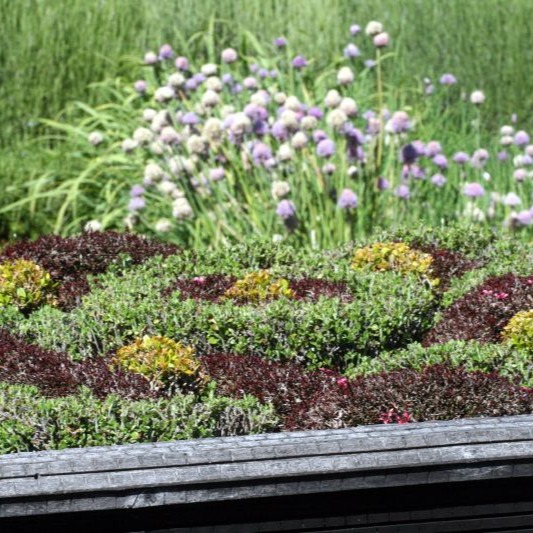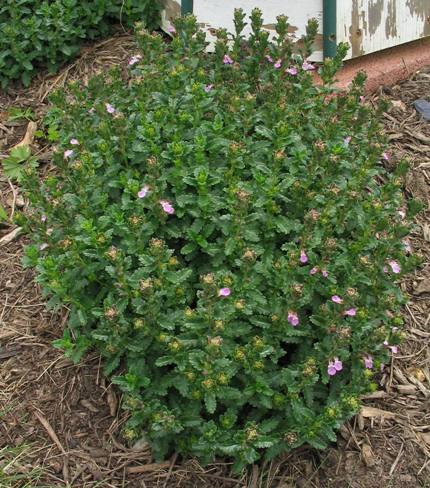Teucrium x lucidrys
- Admin

- Oct 16, 2021
- 3 min read
Updated: Jun 29, 2022

This little germander always finds its way into my gardens, in part for its versatility. I have primarily specified T. x lucidrys as filler, but it has so much more to offer. Its compact form lends itself to tight little hedges, such as Filoli's miniature knot garden that mimics the larger version in the kitchen garden (first photo below, the dark green circle and border is Teucrium x lucidrys). If you have seen traditional flower beds framed with boxwood, this species offers a unique twist on such borders due to its seasonal bloom and small stature.
When grown in informal masses, the flower sprays rise above the dark green foliage where the magenta blooms become a painterly drift. I have noticed on projects that it appears to prefer warmer microclimates and seems less prolific if contending with wind and cold. As with many of these observations, they should be compared with the experience of others.
Native to the Mediterranean region, T. x lucidrys is drought tolerant manages most soils with good drainage. Bees love the tubular flowers, perfect for a pollinator garden. Because of its compact size, add this one to containers where it can billow over the edge of pots.
One point to consider regarding maintenance; deadheading and shaping can be tedious if planted in large masses. Deadheading means crouching over the plants, a tedious task similar to pruning lavender without the fragrant reward. As wall germander finishes blooming, gardeners should take this opportunity to return each plant to a desirable shape, depending on how they are used.
Note: nurseries and people in the trade that do not like change (I am including myself in this comment), still refer to wall germander as Teucrium chamaedrys. The most current name is identified here, but often references will include the older name as a synonym. Don't be like me a date yourself with old names...Teucrium x lucidrys for the win.
Overview by Northern California landscape architect, Jeff Wortham:
facts
Botanical Name: Teucrium x lucidrys
Teucrium: Greek, teukrion, thought to honor Teucer, king of Troy.
Lucidrys: Bright and shiny, probably in reference to the glossy leaves.
Common Name: Wall germander
Family Name: Lamiaceae
Origin: Mediterranean: North Africa, western Asia, Europe
design considerations
Positioning: Foreground next to pathways, raised planting areas
Garden Themes: Pollinator/butterfly, border, drought, cottage, cutting/herb (apparently for tea), rock, Mediterranean, courtyard/patio
Uses: Accent, border, mass, container
identifying characteristics
Type: Herbaceous perennial with woody base
Form: Round, mound, spreading, upright when blooming
Texture: Fine
Size: 18" tall when in bloom, 2' wide
Outstanding Feature(s): Flower, form
Stem: Red-green turning green-brown with age; pubescent
Leaf:
Type: Simple
Arrangement: Decussate
Shape: Ovate
Margin: Crenate to serrate
Color: Deep green
Surface: Glabrous
Flower: Summer to Autumn. Tiny, tubular flowers, axial and whorled sprays, magenta
Fruit: Not observed at time of posting.
cultural requirements, tolerances & problems
Sunset Zones: 2-24
USDA Zones: 5-9
Light: Sun
WUCOLS SF Bay Area Hydro Zone: Low
Soil:
Texture: Sand to rocky
Moisture Retention: Well-drained
pH: Neutral to highly alkaline
Tolerances: Deer, drought
Problems:
Branch Strength: N/A
Insects: Spider mites
Disease: Rust, powdery mildew, leaf spot
maintenance
citations & attributions
Bayton, R. (2019). The Royal Horticultural Society's the Gardener's Botanical: An Encyclopedia of Latin Plant Names. London: Mitchell Beazley.
Extension Gardener. "Teucrium chamaedrys." North Carolina State University, Raleigh. Accessed on October 16, 2021, from https://plants.ces.ncsu.edu/plants/teucrium-chamaedrys/.
Norris Brenzel, K. (Ed.). (2012). The New Sunset Western Garden Book. New York: Time Home Entertainment, Inc.
Plant Finder. "Teucrium chamaedrys." Missouri Botanical Garden, St. Louis. Accessed on October 16, 2021, from https://www.missouribotanicalgarden.org/PlantFinder/PlantFinderDetails.aspx?kempercode=f910.
Water Use Classification of Landscape Species. "WUCOLS IV Plant List." University of California, Division of Agriculture and Natural Resources, Davis. Accessed on October 12, 2021.
Photos:
Feature flower detail: "Teucrium chamaedrys 290807" by Bernd Haynold is licensed under Creative CommonsAttribution-Share Alike 3.0 Unported.
Flower mass: "Teucrium chamaedrys 001" by H. Zell is licensed under Creative CommonsAttribution-Share Alike 3.0 Unported.
Miniature knot garden: "Filoli Knot Garden Miniature" by Jean is licensed under Creative Commons Attribution 2.0 Generic (CC BY 2.0).
All other photos by TELCS.
















Comments